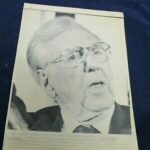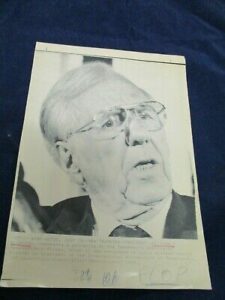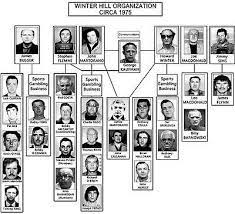The Forgotten History of William McCarthy and Boston Teamsters Local 25


William J.McCarthy of Boston Teamster Local 25, former president of the Internantional Brotherhood of Teamsters.
Editors’ note: This is the second of two articles with background about the union’s recent history, intended to inform readers about the election of officers now taking place in the Teamsters union (International Brotherhood of Teamsters).
At the first 2021 Teamsters debate, candidate for General President (GP) of the International Brother of Teamsters (IBT), Sean O’Brien had the arrogance to introduce himself by saying: “Good evening brothers and sisters, my name is Sean O’Brien…I’m a proud fourth generation Teamster out of the greatest local union in the entire country…Local 25.” In fact, the history of Teamster Local 25, which has some accomplishments to be proud of, is in recent history largely shameful.
Unfortunately, most working teamsters do not know the history of the IBT let alone of Local 25—nor why O’Brien would suggest that Dan Tobin and Bill McCarthy were great Boston Teamster leaders. This article will demonstrate that O’Brien’s assessment of Local 25 is incorrect. But more importantly it will show that by understanding the Teamsters past, union members can acquire the ability to become agents of their own history and change its course.
In 1988 William “Bill” McCarthy became the last of the Teamsters leaders chosen without a vote of rank-and-file members to become General President. He was born in the Charlestown sector of Boston in 1919, which is home to troubled Local 25. As an adolescent growing up in the Great Depression era, McCarthy did what some other kids his age engaged in: stealing. Like other juveniles in urban centers during the most difficult of economic times in American history, he became a hoodlum tailgater—stealing off the backs of trucks that transported goods all over the New England area as well as from the docks of Boston harbor.
In the glory days of Prohibition in the 1920s, the city of Boston was typical of an American city where organized crime found its footing.[1] After President Franklin Delano Roosevelt repealed Prohibition in 1933, organized crime activity transitioned into labor racketeering and loansharking with money sometimes looted from union funds. Legend has it that when Bill McCarthy was fifteen years old, he stole a car and took Boston police on a high-speed chase. The young hoodlum ditched the car near the offices of Local 25 and hid in the cab of a tractor-trailer. According to this tale, McCarthy and the driver of the tractor where he had hid became friends, and Bill persuaded the older man to teach him to drive the big rig. Eager to start a career as a truck driver and join the Teamsters, in 1936 McCarthy reputedly stole a blank baptismal certificate and falsified his birth date so he could qualify for a chauffeur’s license to become a driver and union member. However true the story may be, tales such as this one are a traditional part of the lore of Boston’s tight-knit ethnic communities, whether Irish, Italian or some other immigrant group.
McCarthy joined the Teamsters as a driver at the age of seventeen in 1936 and gradually moved up the bureaucratic ladder of the union. In 1941 he was assigned as shop-steward and elected business agent in 1947. He began his career at the headquarters of Local 25 in a time when organized crime had become a concern in the media and among politicians. Many large cities and states had become preoccupied with the way organized crime had infiltrated interstate commerce trough labor racketeering. Tennessee Senator Estes Kefauver held hearings in 1950 and 1951 that were broadcast on television and brought into American living rooms the faces of assorted mobsters who speaking live on television claimed their Fifth Amendment, declining to testify on the grounds they might be incriminated. Despite their tight-lipped responses, Americans were disturbed by the role of criminals in the unions.

When McCarthy took over as head of Local 25 in 1955, just next door in the Winter Hill neighborhood of Somerville—James “Buddy” McLean a hoodlum, a truck driver, and member of Local 25 had made a name for himself as founder and leading boss of the Winter Hill Gang. One of the gang’s most profitable criminal enterprise became the hijacking of trucks whose drivers were Teamsters—and most of those crimes were inside jobs. Among other Somerville hoodlums and Teamsters were men like McClean’s right-hand man, Howie Winter, Joe “Joe Mac” McDonald and Jimmy Sims. Sims was best known for his expertise as the quickest car-stealing whiz in Boston. In the Winter Hill neighborhood, locals bragged that Simms could hot-wire a Ford in thirty seconds.[2] All these Winter Hill boys were celebrated in their neighborhood for their criminal knack and toughness. A generation younger than McCarthy, they were also praised by the Teamster leader as they reminded him of his own juvenile delinquent past. Their affiliation benefitted both as McCarthy used the Winter Hill Gang to enforce his policies against any dissenters, and the gang members used their membership at Local 25 to divert attention from their criminal activities.
The Winter Hill Teamsters came to dominate the rackets of northern Boston that included running numbers, loansharking, warehouse burglaries, bank robberies, armored-car heists and truck hijackings. Upon the murder of McLean in 1965 during the height of the Somerville and Charlestown neighborhood gang war, often referred to as the Boston Irish Gang War, Winter inherited control of the gang. Both McLean and Winter had been close friends since childhood and they had both joined Local 25 at the age of fourteen.[3] When Winter took over the Winter Hill Gang, he sought to expand his criminal enterprise into the greater Boston area, so in 1975 he recruited South Boston’s most feared gangster, James “Whitey” Bulger to join him. At the time Winter didn’t know that Whitey was an informant for the FBI working to take down the Italian gangs in the North End and other Winter Hill Gang associates. With the assistance of Whitey, in 1979 Winter was indicted for money laundering, income tax evasion and horse-race fixing. With Winter behind bars, Whitey proceeded to take control of the Winter Hill Gang and expanded the gang’s criminal enterprise beyond New England. At Local 25, his main man, James Flynn, took full control of the local’s motion picture division’s ongoing extortion policies. Flynn who is still alive was a close friend of Sean O’Brien’s father William “Billy” O’Brien and for over thirty-years the two worked together in Local 25’s movie division as crew chiefs.
By 1960 the McClellan hearings chaired by Robert F. Kennedy had exposed the involvement of La Cosa Nostra (LCN), that is the Italian Mafia, in trade unions which at the time had more rank-and-file Teamsters in New England than any other region in the country.[4] Based in Providence Rhode Island, the Patriarca crime family led by Raymond Patriarca, Sr. for many years the boss of the New England LCN, had exerted influence over the regions Laborers International Union and the Teamsters. In Boston’s Italian North End, which is located south of Charlestown just across the North Washington Street Bridge, was the headquarters of Boston’s underboss to the Patriarca crime family, Jerry Angiulo. Located just a few minutes away, McCarthy, the head of Local 25, fell under the spell of the North End’s Italian mob underboss.
Through the first half of the 1960s, the IBT under Hoffa had gone to war with the federal government over the union’s obvious ties to the Mafia. But in July 1964, Hoffa finally lost that battle and was found guilty on two counts of jury tampering and embezzlement of union pension funds. He was sentenced to thirteen years in prison. In less than four years, Kennedy’s efforts resulted in the indictment of 201 Teamster officers and the conviction of 126 of them.[5] Hoffa managed to stay out of prison for three years until his appeal was denied in 1967. While in prison Hoffa left the union under the tutelage of his own personal gofer, Frank Fitzsimmons who allowed the LCN to further take control of the IBTs decision making. In 1969 McCarthy with the blessing of the LCN was appointed International Vice-President.
In 1972, again with the nod of the Patriarca crime family, McCarthy gained another appointment as principal officer of New England’s Teamsters Joint Council 10. By the 1970s the LCN’s labor racketeering had become the top organized crime priority for both the FBI and Department of Justice (DOJ).[6] A decade later the 1983-1986 work of the President’s Commission on Organized Crime (PCOC) left no doubt about the LCN’s firm grip on organized labor.[7] When Fitzsimmons died of lung cancer in 1981, Roy Williams replaced him as General President. Williams who later admitted to being under the control of Nick Civella, boss of the Kansas City LCN family told the PCOC, “every big local union…had some connection with organized crime.”[8] In fact the PCOC found evidence that the LCN had influence in over thirty-eight IBT locals and joint councils, including Boston’s Local 25 and New England’s Joint Council 10. By March 1986, the PCOC had urged the DOJ to bring a civil Racketeering Influenced and Corrupt Organization Act (RICO) lawsuit against the IBTs international officers and their LCN associates.
In April 1983, Williams resigned as IBT president after a jury sentenced him to fifty-five years in prison following his conviction for attempting to bribe Nevada Senator Howard Cannon in favor of votes blocking interstate trucking deregulation. With the LCN bosses’ approval, the GEB chose Cleveland’s Local 507 boss, Jackie Presser as new GP. He was the son of well distinguished labor racketeer William “Bill” Presser—a high-ranking officer that had held numerous offices within the IBT and sat on the board of the troubled Central States Pension Fund. According to the PCOC, Local 507 was “infested with LCN associates and convicted felons.”[9] Presser’s ascendency to the union’s top position took place with the blessing of Cleveland mob boss Angelo Lonardo and other Midwest and East Coast families.
As rumors swirled after Ronald Reagan’s reelection win in 1984 that the DOJ was preparing to launch a civil RICO suit against the Teamsters, Presser playing victim responded: “Takeovers of unions are nothing new—Communists and Fascists have been doing so for decades. However, it is a sad day in the history of the United States and the American labor movement when such tactics are employed.”[10] The IBT organized a few rank-and-file rallies against the government’s proposed suit and 264 members of Congress delivered a petition in December 1987 urging Congress not to file the civil RICO lawsuit against the IBT.[11] Nevertheless, U.S Attorney Rudy Giuliani proceeded to file the much much-anticipated civil RICO complaint against the IBT in June 1988.
Meanwhile in Boston, movie crew Teamsters like Jimmy Flynn went on to develop the most notorious and long-lasting reputations of mobbed-up Local 25 members. His legacy goes back to when Buddy McLean founded the Winter Hill Gang in 1955. Flynn grew-up with McLean, Howie Winter, “Joe Mac” McDonald and car thief—Jimmy Sims. He was an original member of the Winter Hill Gang and became a high-ranking member of Local 25’s movie crews.[12] His mugshot also appears on the FBI’s 1975 organizational chart of the Winter Hills Gang.
In 1997 Flynn managed to play a part as judge in the 1997 hit film Good Will Hunting starring Matt Damon and Robin Williams. Flynn’s part as judge in the film was amusing considering he had been indicted and tried for the 1982 murder of another Local 25 Teamster and associate of the Winter Hill Gang, Brian “Balloonhead” Holloran. When a warrant for his arrest was issued, Flynn went “on the lam” for two and half years. In 1986 Flynn was finally put on trial, but on the stand was able to establish that he was nowhere near the murder site. In 1999, Kevin Weeks who was Whitey Bulger’s personal bodyguard disclosed the description of the Holloran hit. Both Whitey and his right-hand man Steve “the Rifleman” Flemmi had committed the hit themselves.[13] The trailer on the 2015 film Black Mass starring Jonny Depp as Whitey Bulger depicts the Hollaran hit. Ironically, according to IGN Entertainment both Flynn and Billy O’Brien sat on the Winter Hill Gang movie negotiations.[14]
The 1980s would become the most embarrassing and turbulent of times for the Teamsters as the Reagan administration waged open war against organized labor and Republicans introduced so-called right-to-work legislation in several states. Fitzsimmons (1981), Williams (1983) and Presser (1988) all finished their presidencies in legal trouble and as disgraced FBI informants against their mob bosses. In 1988 McCarthy succeeded to the general presidency after a divisive political struggle within the mob controlled GEB in a nine-to-eight vote. The civil RICO suit had already been filed when he was sworn in. But more important to note is that McCarthy was not promoted to the highest office of the Teamsters based on his merits and working-class fighting credentials as O’Brien seems to have suggested. McCarthy was a loyal puppet of organized crime and he himself had allowed gangsters and thugs to infiltrate the ranks of Local 25 and Joint Council 10 going back to the days he had gained control of their offices in 1955 and 1972.
The 113-page civil RICO complaint filed by the Southern District Court of New York (SDNY) in short accused the Teamsters of being a subsidiary of organized crime. McCarthy as head of the union was forced in March 1989 to agree to a consent decree that would rid the union of corruption and organized crime involvement. The consent decree also required several amendments to the IBT constitution that included rank-and-file members gaining the right-to-vote for the GEB and ending the undemocratic and nepotistic system of appointments. From 1988 when McCarthy was appointed General President till the election of 1991, he proved to be incompetent, incapable and weak. The daily newspapers and television news stories about the Teamsters further tarnished the reputation of the Boston leader.
McCarthy had initially announced that he would seek reelection, but he was quickly forced to abandon his candidacy when he failed to secure the support of the majority of the GEB. With the infiltration of Winter Hill Gang thugs at Local 25 and the constant stories making the headlines of the troubled local on the front pages of The Boston Globe and The Boston Herald, in 1991 McCarthy subsequently lost his local election to George Cashman, an opportunist disguised as a reformer. McCarthy followed with his resignation as president of Joint Council 10, which he had ran since 1972. He retired from the Teamsters in utter disgrace.
Is this what the aspiring candidate for Teamsters General President-Sean O’Brien has referred to as the greatest Teamster local in the country?
O’Brien is a byproduct of a tradition of organized crime that is unique to Boston Teamsters Local 25. But it should come as no surprise to Teamsters. O’Brien’s own father was part of the criminal element that has roamed the halls of Local 25 since the days when William “Bill” McCarthy took control of the local in 1955 and allowed the Patriarca crime family to control him and the Winter Hill Gang to run Boston’s rackets.
[1]T.J. English, Where the Bodies Were Buried: Whitey Bulger and the World That Made Him, (Harper Collins: New York, 2015), 75.
[2] Howie Carr, Hitman – The Untold Story of Johnny Mortorano: Whitey Bulger’s Enforcer and the Most Feared Gangster in the Underworld, (Doherty Associates Book: New York, 2011), 185.
[3] George P. Hasset, “New Book Offers Inside Look at Winter Hill Gang Story,” The Somerville Times, December 16, 2010.
[4] TJ, English, Where the Bodies Were Buried, 76.
[5] Charles Brandt, I Heard You Paint Houses: Frank “The Irishman” Sheeran and Closing the Case on Jimmy Hoffa, (Steerfoth Press: Hanover N.H.), 181.
[6] James, B. Jacobs, Mobsters, Unions and the Feds, (New York University Press: New York, 2006), 2.
[7] James B. Jacobs, Breaking the Devil’s Pact: The Battle to Free the Teamsters from the Mob, (New York University Press: New York, 2011), 2.
[8]PCOC, The Edge: Organized Crime Business, and Labor Unions, Washington D.C.: U.S Government Printing Office, 1986, 89.
[9] The Edge, 105.
[10] Kenneth C. Crowe, Collision: How the Rank and File Took Back the Teamsters, (Scribner Press: New York, 1993), 67.
[11] James B. Jacobs, Busting the Mob: United States V. Cosa Nostra, (New York University Press: New York, 1994), 182-83.
[12] Howie Carr, Hitman, 185.
[13]T.J. English, Where the Bodies Were Buried, 318-319.
[14] IGN Entertainment, “Winter Hill Gang Nets True Crime Figures,” June 17, 2012.